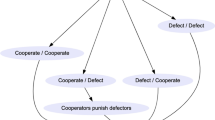Abstract
According to a bioeconomic model called skew selection, individuals form cooperative hierarchies when coping with high risk environments that include predators and cycles of scarce resources. This paper reports a study that used agent-based computer simulations to experimentally test the predictions of skew selection. Results of the experiment showed that successful face-to-face transaction strategies varied with environmental risks. Risks involving resource scarcity favored clustering and stealing. Risks involving predators favored clustering and hoarding. A combination of risks involving resource scarcity and predators favored clustering and sharing. Wealthy donors gained safety-in-numbers to protect them from predators; at the same time, marginal recipients gained resources to protect them from starving. In summary, our findings show that even though natural selection is not a moral process, it can produce moral behavior.
Similar content being viewed by others
References
Alexander R. D. (1974) The evolution of social behavior. Annual review of Ecology and Systematics 5: 325–383
Axelrod R. M. (1984) The evolution of cooperation. Harper Collins Publishers, New York
Boyd R. (2006) The puzzle of human sociality. Science 314: 1555–1556
Cassill D. L. (2002) Yoyo-bang: A risk aversion investment strategy by a perennial insect society. Oecologia 132: 150–158
Cassill D. L. (2003) Rules of supply and demand regulate recruitment to food in an ant society. Behavior Ecology and Sociobiology 54: 441–450
Cassill D. L. (2005) The social gene. Journal of Bioeconomics 7: 73–84
Cassill, D. L. (2006). Why skew selection, a model of parental exploitation, should replace kin selection. Journal of Bioeconomics, 8, 101–119. http://www.springerlink.com/content/63j12k7w561gr667.
Cassill D. L., Kuriachan I., Vinson S. B. (2007) A test of two skew models to explain cooperative breeding among unrelated individuals. Journal of Bioeconomics 9: 19–37
Cassill D. L., Watkins A. (2004) Mogul games: In defense of inequality as an evolutionary strategy to cope with multiple agents of selection. In: Koppl R. (eds) Advances in Austrian economics. Kluwer, Norwell, MA, pp 35–59
Corning P. A. (1996) The cooperative gene: On the role of synergy in evolution. Evolutionary Theory 11: 183–207
Corning P. A. (2007) Synergy goes to war: A bioeconomic theory of collective violence. Journal of Bioeconomics 9: 109–144
Darwin C. (1859) The origin of species. Penguin Books, London (1968 edition)
Darwin C. (1879) The decent of man. Penguin Classics, London
Dawkins R. (1976) The selfish gene. Oxford University Press, Oxford
de Waal F. (1996) Good natured: The origins of right and wrong in humans and other animals. Harvard University Press, Cambridge, MA
Dennett D.C. (1995) Darwin’s dangerous idea. Simon and Schuster, New York
Ghiselin M. T. (1974) The economy of nature and the evolution of sex. University of California Press, Berkeley, CA
Gifford A. (2000) The bioeconomics of cooperation. Journal of Bioeconomics 2: 153–168
Hamilton W. D. (1964) The genetical evolution of social behavior, I & II. Journal of Theoretical Biology 7: 1–52
Hamilton W. D. (1971) Geometry for the selfish herd. Journal of Theoretical Biology 31: 295–311
Hirshleifer J. (1999) There are many evolutionary pathways to cooperation. Journal of Bioeconomics 1: 73–93
Hölldobler B., Wilson E. O. (1990) The ants. Harvard University Press, Cambridge, MA
Landa J. T. (1986) The political economy of swarming in honeybees: Voting-with-the-wings, decision-making costs, and the unanimity. Public Choice 51: 25–38
Landa J. T. (1996) Bioeconomics of schooling fishes: Selfish fish, quasi-free riders, and other fishy tales. Environmental Biology of Fishes 53: 353–364
Landa J. T. (1999) The law and bioeconomics of ethnic cooperation and conflict in plural societies of southeast Asia: A theory of Chinese merchant success. Journal of Bioeconomics 1: 269–284
Landa J. T., Ghiselin M. T. (1999) The emerging discipline of bioeconomics: Aims and scope of the Journal of Bioeconomics. Journal of Bioeconomics 1: 5–12
Maynard-Smith J. (1982) Evolution and the theory of games. Cambridge University Press, New York
Nowak M. A. (2006) Five rules for the evolution of cooperation. Science 314: 1560–1563
Reeves H. K., Keller L. (2001) Tests of reproductive-skew models in social insects. Annual Review of Entomology 46: 347–385
Ridley M. (2003) Nature via nurture: Genes, experience, and what makes us human. Harper Collins Publishers, New York
Rubin P. H. (2002) Darwinian politics: The evolutionary origin of freedom. Rutgers University Press, New Brunswick
Sall J., Lehman A. (1996) JMP start statistics: A guide to statistical and data analysis using JMP and JMP IN software. SAS Institute Inc, Albany, NY
Seeley T. D. (1995) The wisdom of the hive: The social philosophy of honey bee colonies. Harvard University Press, Cambridge, MA
Seger J. (1991) Cooperation and conflict in social insects. In: Krebs J. R., Davis N. B. (eds) Behavioural ecology: An evolutionary approach. Blackwell, Oxford, pp 338–373
Sherman P. W., Jarvis J. U., Alexander R. D. (1991) The biology of the naked mole-rat. Princeton University Press, Princeton, NJ
Sober E., Wilson D. S. (1998) Unto others: The evolution and psychology of unselfish behavior. Harvard University Press, Cambridge, MA
Tullock G. (1999) Some personal reflections o the history of bioeconomics. Journal of Bioeconomics 1: 13–18
Vermeij G. J. (2004) Nature: An economic history. Princeton University Press, Princeton, NJ
Wilson E. O. (1971) The insect societies. Harvard University Press, Cambridge, MA
Wilson E. O. (1975) Sociobiology: The new synthesis. Harvard University Press, Cambridge, MA
Zahavi A., Zahavi A. (1997) The handicap principle: A missing piece of Darwin’s puzzle. Oxford University Press, Oxford
Zimmer C. (2005) Testing Darwin. Discover 26: 28–35
Author information
Authors and Affiliations
Corresponding author
Rights and permissions
About this article
Cite this article
Cassill, D., Watkins, A. The evolution of cooperative hierarchies through natural selection processes. J Bioecon 12, 29–42 (2010). https://doi.org/10.1007/s10818-010-9080-y
Published:
Issue Date:
DOI: https://doi.org/10.1007/s10818-010-9080-y




